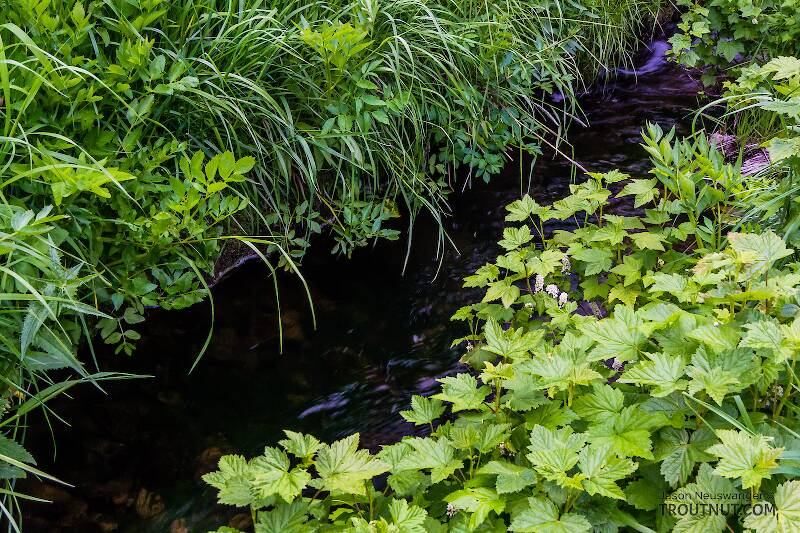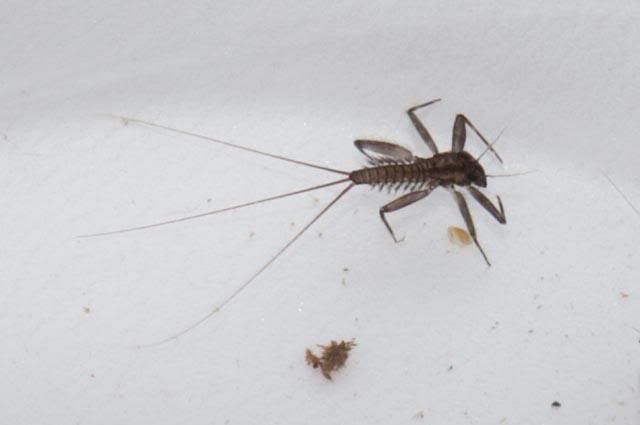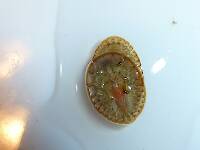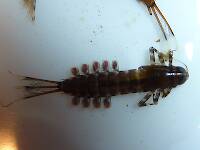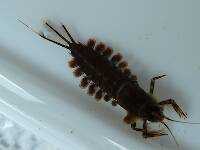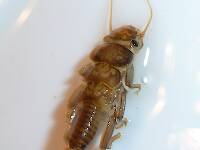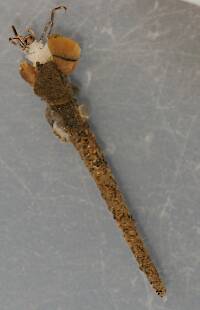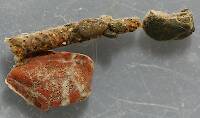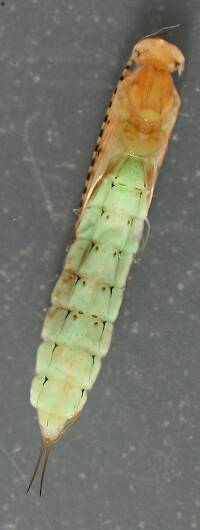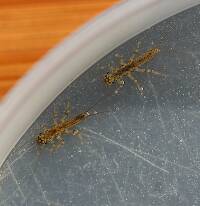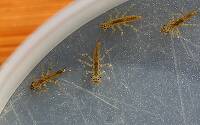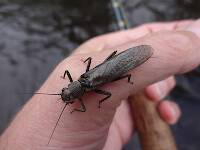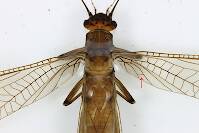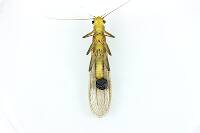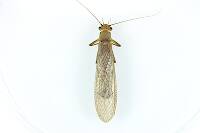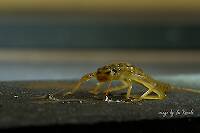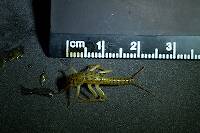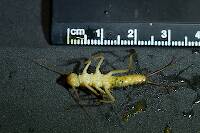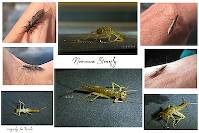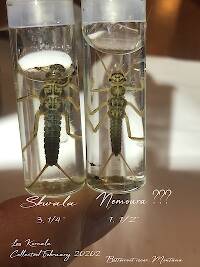
Salmonflies
Pteronarcys californica
The giant Salmonflies of the Western mountains are legendary for their proclivity to elicit consistent dry-fly action and ferocious strikes.
Featured on the forum

Troutnut is a project started in 2003 by salmonid ecologist Jason "Troutnut" Neuswanger to help anglers and
fly tyers unabashedly embrace the entomological side of the sport. Learn more about Troutnut or
support the project for an enhanced experience here.
Cussfly16
Posts: 10
Posts: 10
Cussfly16 on Feb 18, 2012February 18th, 2012, 6:44 pm EST
So the plot thickens on that green larva thing...lol. Here is more pics for you guys to educate me on...
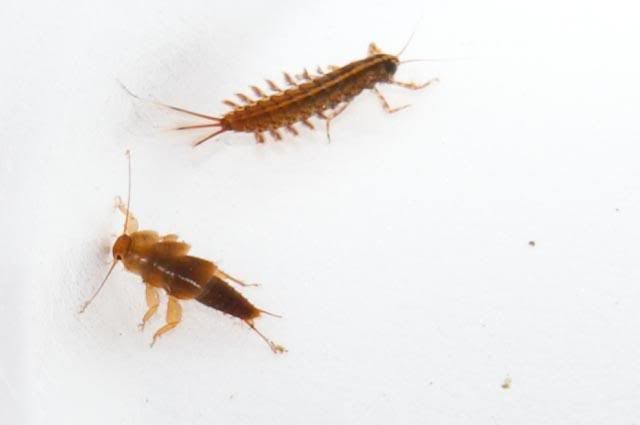
Isonychia and Little Roach Stonefly?
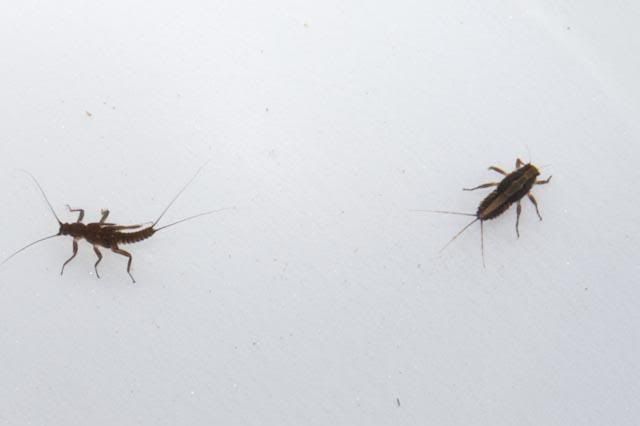
Early Winter Stone and E.Floripara???
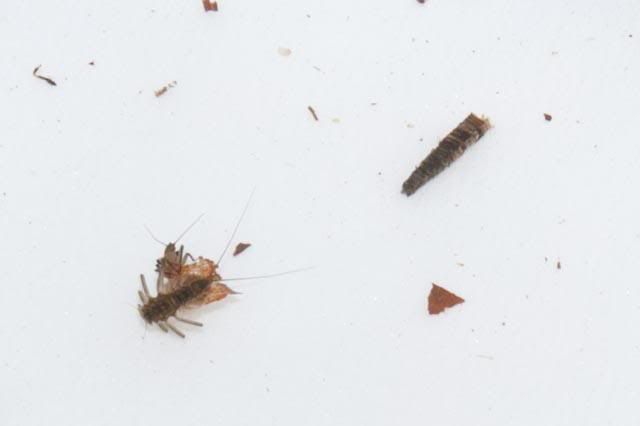
Quill Gordon and a Grannom?
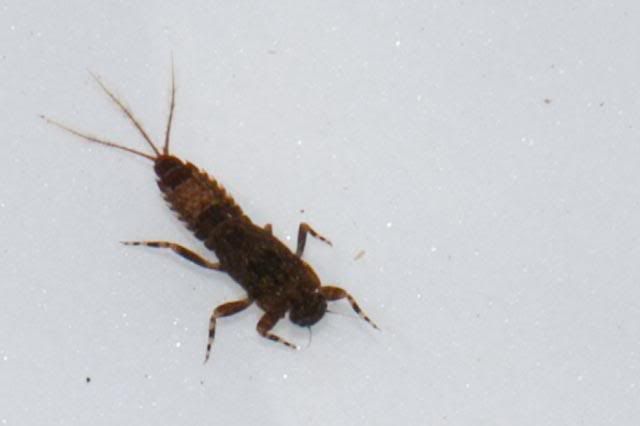
Hendrickson?

Black or Brown stone?

Worm? Annelid? Tubifex? Confusion? check!!!!
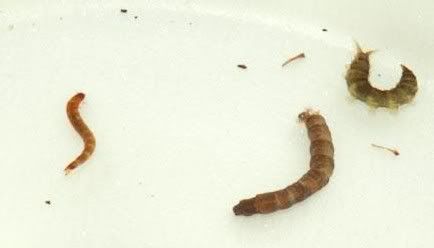
Cranefly and what else?
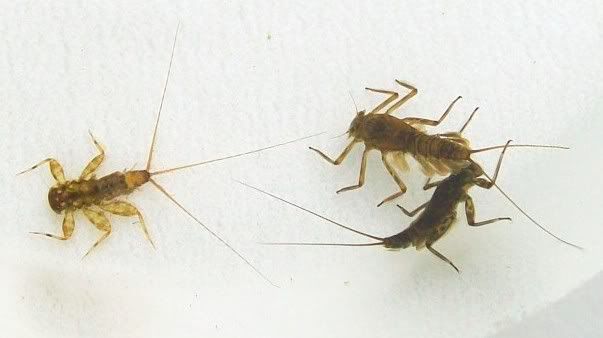
March Brown and two QG's?
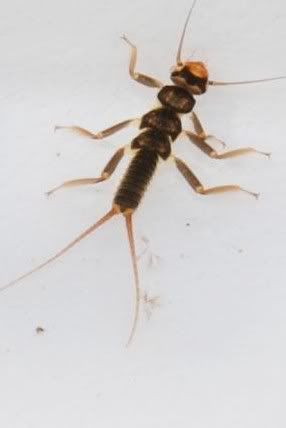
Something different with this stone..?
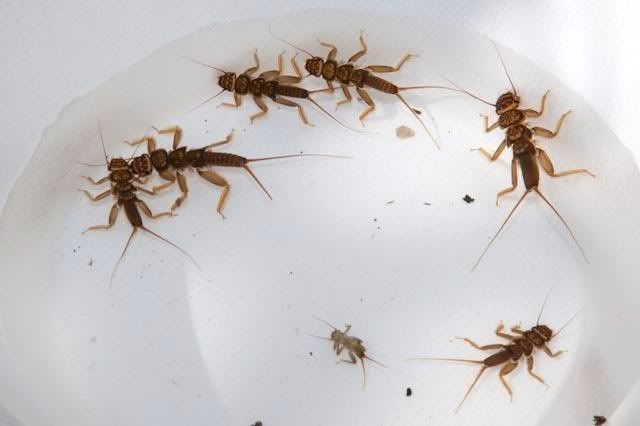
Bowl of goldens?
I have to find this interesting pic of a clinger nymph that had three tails, but wasn't a march brown. His coloring was not mottled at all, but he looked more outlined with lineal designs, He stood out in the bowl of QG's, lets put it that way. Thank you everyone, I have learned more about my river over the last couple of days thanks to you all. I really appreciate the expertise

Isonychia and Little Roach Stonefly?

Early Winter Stone and E.Floripara???

Quill Gordon and a Grannom?

Hendrickson?

Black or Brown stone?

Worm? Annelid? Tubifex? Confusion? check!!!!

Cranefly and what else?

March Brown and two QG's?

Something different with this stone..?

Bowl of goldens?
I have to find this interesting pic of a clinger nymph that had three tails, but wasn't a march brown. His coloring was not mottled at all, but he looked more outlined with lineal designs, He stood out in the bowl of QG's, lets put it that way. Thank you everyone, I have learned more about my river over the last couple of days thanks to you all. I really appreciate the expertise
Oldredbarn on Feb 19, 2012February 19th, 2012, 5:49 am EST
Cussfly,
Thanks for getting us back on track here! It's been a while since we have been talking bugs and not arguing with each other over, well, just about everything...:)
Could spring and opening day be too far off?! Yahoooo!
Miss G. here on this one. But you woke up a few of the other "bug boys"...Thanks!
Spence
Your little spot has some interesting diversity...
Thanks for getting us back on track here! It's been a while since we have been talking bugs and not arguing with each other over, well, just about everything...:)
Could spring and opening day be too far off?! Yahoooo!
Miss G. here on this one. But you woke up a few of the other "bug boys"...Thanks!
Spence
Your little spot has some interesting diversity...
"Even when my best efforts fail it's a satisfying challenge, and that, after all, is the essence of fly fishing." -Chauncy Lively
"Envy not the man who lives beside the river, but the man the river flows through." Joseph T Heywood
"Envy not the man who lives beside the river, but the man the river flows through." Joseph T Heywood
Konchu on Feb 20, 2012February 20th, 2012, 1:39 pm EST
Hard to tell on my screen, but maybe Heptagenia of some kind (if gills 7 have a ventral fibrilliform portion). I may be missing some color pattern, but it looks pretty gray to me.
Entoman on Feb 20, 2012February 20th, 2012, 8:19 pm EST
Hi Cussfly,
I second Spence's (Oldredbarn) comments.
BTW - Welcome to the forum! I'm sorry if I failed to do this before...
Whew! Your last post is a lot to work on, but I did my best pretty much off the top of my head with minimal research, simply because of the sheer size of your request. For the future, if you brake them up into individual posts you will get more effort/responses on them individually from various contributors, and they will also be of greater value to the forum as they can be linked as examples in the sites encyclopedia. Also, photos that show greater resolution and ventral as well as dorsal are critical if you are interested in getting further in depth as to the genus/species of the critters in your river. Try setting your camera to macro mode and getting a little closer ( you will probably have to rest your hand on something and use a a delayed shutter as well).
Now for the bugs:
Isonychia - yes, most likely bicolor (Leadwing Coachman) but SC has several species that are possibilities.
Roach Stone - yes, probably Tallaperla maria (Common Roach Stone), but need to see the gills to know for sure.
Early Winter Stone - No, probably Taenionema (Little Eastern Willowfly)
E.Floripara - yes, though there is no accepted common name for this guy that I'm aware of. If there's enough of them to fish over, perhaps you and your fishing buds can come up with one. It's a blank canvass, so why not? :) How about Little Winter Hendrickson? :)
Worm - I don't do worms, Cussfly...:)
Cranefly and what else - yes. The one on the left? The Picture is very fuzzy, but I'm thinking the order Coleoptera (Aquatic beetle larvae). The overall caddis look and bifid terminal abdominal segment makes me think a genus of the family Elmidae. Edit: The one on the right is a Snipefly (see posts below)
March brown and two QG - No. The species Maccaffertium vicarium (American March Brown, Gray Fox) is not recorded for SC, and neither is Epeorus pleuralis (Quill Gordon). However, it is probable that the former is a species of Maccaffertium and the latter two are definitely species of Epeorus. One could possibly be vitreus (Little yellow Quill).
Something different with this stone - Perlodidae, but not Isoperla (Stripetails, Little Yellow Stones). It's one of the genera commonly called "Springflies." There are four in SC. Anybody recognize the unique head pattern? It looks familiar, but I can't place it in my memory.
The bowl full of goldens - yes & no. "Golden Stone" is a common name that originally applied to West Coast perlids. The name is now used in the East in some circles, but they are traditionally referred to as "Common" or "American Stoneflies." These are all Acroneura, probably A. abnormis (Common Stonefly) but possibly A. carolinensis (Carolina Stone).
Mystery clinger - the distortion due to the oblique angle and lack of focus of the photo makes this one difficult. However, I agree with Konchu that this looks like a species of the Heptagenia genus.
Hope this is helpfull!
Best regards,
Kurt
I second Spence's (Oldredbarn) comments.
BTW - Welcome to the forum! I'm sorry if I failed to do this before...
Whew! Your last post is a lot to work on, but I did my best pretty much off the top of my head with minimal research, simply because of the sheer size of your request. For the future, if you brake them up into individual posts you will get more effort/responses on them individually from various contributors, and they will also be of greater value to the forum as they can be linked as examples in the sites encyclopedia. Also, photos that show greater resolution and ventral as well as dorsal are critical if you are interested in getting further in depth as to the genus/species of the critters in your river. Try setting your camera to macro mode and getting a little closer ( you will probably have to rest your hand on something and use a a delayed shutter as well).
Now for the bugs:
Isonychia - yes, most likely bicolor (Leadwing Coachman) but SC has several species that are possibilities.
Roach Stone - yes, probably Tallaperla maria (Common Roach Stone), but need to see the gills to know for sure.
Early Winter Stone - No, probably Taenionema (Little Eastern Willowfly)
E.Floripara - yes, though there is no accepted common name for this guy that I'm aware of. If there's enough of them to fish over, perhaps you and your fishing buds can come up with one. It's a blank canvass, so why not? :) How about Little Winter Hendrickson? :)
Worm - I don't do worms, Cussfly...:)
Cranefly and what else - yes. The one on the left? The Picture is very fuzzy, but I'm thinking the order Coleoptera (Aquatic beetle larvae). The overall caddis look and bifid terminal abdominal segment makes me think a genus of the family Elmidae. Edit: The one on the right is a Snipefly (see posts below)
March brown and two QG - No. The species Maccaffertium vicarium (American March Brown, Gray Fox) is not recorded for SC, and neither is Epeorus pleuralis (Quill Gordon). However, it is probable that the former is a species of Maccaffertium and the latter two are definitely species of Epeorus. One could possibly be vitreus (Little yellow Quill).
Something different with this stone - Perlodidae, but not Isoperla (Stripetails, Little Yellow Stones). It's one of the genera commonly called "Springflies." There are four in SC. Anybody recognize the unique head pattern? It looks familiar, but I can't place it in my memory.
The bowl full of goldens - yes & no. "Golden Stone" is a common name that originally applied to West Coast perlids. The name is now used in the East in some circles, but they are traditionally referred to as "Common" or "American Stoneflies." These are all Acroneura, probably A. abnormis (Common Stonefly) but possibly A. carolinensis (Carolina Stone).
Mystery clinger - the distortion due to the oblique angle and lack of focus of the photo makes this one difficult. However, I agree with Konchu that this looks like a species of the Heptagenia genus.
Hope this is helpfull!
Best regards,
Kurt
"It's not that I find fishing so important, it's just that I find all other endeavors of Man equally unimportant... And not nearly as much fun!" Robert Traver, Anatomy of a Fisherman
Cussfly16
Posts: 10
Posts: 10
Cussfly16 on Feb 21, 2012February 21st, 2012, 3:50 am EST
Kurt,
Thank you so much for your reply. I am not going to lie, you guys have really educated and surprised me. I have to ask, what do you mean by Quill Gordons and March Browns have not been "recorded" for SC? That I don't understand. After doing some looking on here, I realize the one that I called a March Brown could also be a Cahill nymph as well. But fellas we have adults that look just like Quill Gordons and March Browns... Well at least they do to a layman. You see I am approaching this from a flyfisher and fly tiers perspective, and I realize that is not very scientific.LOL! See, what I find most frustrating is that I cannot find a study of what insects my river contains, even though I am sure Clemson has an entomology department that did a study on the lower river. Regardless, thanks guys very much for all of your help
Thank you so much for your reply. I am not going to lie, you guys have really educated and surprised me. I have to ask, what do you mean by Quill Gordons and March Browns have not been "recorded" for SC? That I don't understand. After doing some looking on here, I realize the one that I called a March Brown could also be a Cahill nymph as well. But fellas we have adults that look just like Quill Gordons and March Browns... Well at least they do to a layman. You see I am approaching this from a flyfisher and fly tiers perspective, and I realize that is not very scientific.LOL! See, what I find most frustrating is that I cannot find a study of what insects my river contains, even though I am sure Clemson has an entomology department that did a study on the lower river. Regardless, thanks guys very much for all of your help
Konchu on Feb 21, 2012February 21st, 2012, 8:22 am EST
Here is a link to a scientific publication with a 2008 list of South Carolina mayflies . South Carolina is home to 185 recorded species of mayflies (which means they show up in the scientific literature), making it one of the North American states or provinces with greatest species richness; it is arguably second only to neighboring North Carolina, which has at least 207 species.
Entoman on Feb 21, 2012February 21st, 2012, 8:41 am EST
Hi Cussfly,
You're welcome. As to common names, there are four general categories:
1. Accepted scientific common names (not to be confused with the latin ones)
Examples - Springfly, Carolina Stone
2. Angler common names referencing individual species
Examples - Quill Gordon, Hendrickson
3. Angler common names referencing multiple species, sometimes even multiple families
Examples - March Brown, Blue-winged Olive
4. Common names that aren't so common. These are used by anglers on a highly individualized or regional basis for critters that nobody outside their circle has the slightest idea what they are referencing. These are the source for 2 and 3 above from ones that stick and grow in popularity.
As to distribution, there are a multitude of papers that have recorded the distribution of mayflys. Many have been compiled into lists that can be found at places like Purdue University's Mayfly Central and our good friend Taxon's website, www.flyfishingentomology.com. It must be said that these records are incomplete in many instances, as some locations have not been thoroughly explored and documented, but they are certainly reliable in a general sense. Coupled with incomplete taxonomic characters available in most photos (to a greater or lesser extent), many if not most determinations are somewhere on the scale between "highly probable" and "best educated guess". Some are no better than speculation.
BTW - I inadvertantly left out a few from your post. This was not on purpose, they just got lost in the shuffle:
Quill Gordon & a Grannom - no and yes. The former is probably Epeorus vitreus (Little Yellow Quill). The latter looks to be Brachycentrus. Species of this genus go by many common names. American Grannom, Apple Caddis & Shadfly are three common ones, but there are more, depending on which species this is.
Hendrickson - No. This is most likely Ephemerella invaria (Sulfur Dun). Besides being recorded from SC while subvaria has not, invaria does quite well in warmer water. Taxonomically, some invaria have double banded tibia (as with your specimen) while subvaria has single bands.
Black or brown Stone - No. Giant Black Stone is the common name traditionally used for Pteronarcys dorsata, though the western name "Salmonfly" is increasingly being used in more circles. I'm not aware of the common name Brown Stone being used for any particular family, let alone genus or species. My best guess is that this is Paragnetina fumosa (Smokey Stone).
You're welcome. As to common names, there are four general categories:
1. Accepted scientific common names (not to be confused with the latin ones)
Examples - Springfly, Carolina Stone
2. Angler common names referencing individual species
Examples - Quill Gordon, Hendrickson
3. Angler common names referencing multiple species, sometimes even multiple families
Examples - March Brown, Blue-winged Olive
4. Common names that aren't so common. These are used by anglers on a highly individualized or regional basis for critters that nobody outside their circle has the slightest idea what they are referencing. These are the source for 2 and 3 above from ones that stick and grow in popularity.
As to distribution, there are a multitude of papers that have recorded the distribution of mayflys. Many have been compiled into lists that can be found at places like Purdue University's Mayfly Central and our good friend Taxon's website, www.flyfishingentomology.com. It must be said that these records are incomplete in many instances, as some locations have not been thoroughly explored and documented, but they are certainly reliable in a general sense. Coupled with incomplete taxonomic characters available in most photos (to a greater or lesser extent), many if not most determinations are somewhere on the scale between "highly probable" and "best educated guess". Some are no better than speculation.
BTW - I inadvertantly left out a few from your post. This was not on purpose, they just got lost in the shuffle:
Quill Gordon & a Grannom - no and yes. The former is probably Epeorus vitreus (Little Yellow Quill). The latter looks to be Brachycentrus. Species of this genus go by many common names. American Grannom, Apple Caddis & Shadfly are three common ones, but there are more, depending on which species this is.
Hendrickson - No. This is most likely Ephemerella invaria (Sulfur Dun). Besides being recorded from SC while subvaria has not, invaria does quite well in warmer water. Taxonomically, some invaria have double banded tibia (as with your specimen) while subvaria has single bands.
Black or brown Stone - No. Giant Black Stone is the common name traditionally used for Pteronarcys dorsata, though the western name "Salmonfly" is increasingly being used in more circles. I'm not aware of the common name Brown Stone being used for any particular family, let alone genus or species. My best guess is that this is Paragnetina fumosa (Smokey Stone).
"It's not that I find fishing so important, it's just that I find all other endeavors of Man equally unimportant... And not nearly as much fun!" Robert Traver, Anatomy of a Fisherman
PaulRoberts on Feb 21, 2012February 21st, 2012, 9:16 am EST
I'm thinking that that black/brown is Acroneuria abnormis. I'd keyed some central NY stones once upon a time and A. ab. was pretty recognizable.
The "Goldens" might be A. carolinensis -if that still stands.
Hey, as to the "Roach" -The one's we had in CNY was Peltoperla, is Tallaperla a re-naming or a different genus? Ours did not have the dorsal racing stripe.
The "Goldens" might be A. carolinensis -if that still stands.
Hey, as to the "Roach" -The one's we had in CNY was Peltoperla, is Tallaperla a re-naming or a different genus? Ours did not have the dorsal racing stripe.
Entoman on Feb 21, 2012February 21st, 2012, 10:33 am EST
Thanks, for the link, Luke! I have been working with Distribution of Mayfly Species of North America, by R. P. Randolph, which doesn't list the "big three" superhatch species for SC. But it doesn't include this newer data, either. :)
Cussfly - I stand corrected. Apparently the species Ephemerella subvaria (Hendrickson), Maccaffertium vicarium (American March Brown, Gray Fox), and Epeorus pleuralis (Quill Gordon) have been reported in SC. However, their importance to anglers looks to be very doubtful as it is highly unlikely that the existance of numbers large enough to cause fishable hatches could have gone unreported until recently. I don't see anything in your specimens or this new data that alters my opinions.
Check out the link that Konchu provided, Cussfly. The distribution of species is reported from specific locations, so perhaps you'll find your waters there?
Cussfly - I stand corrected. Apparently the species Ephemerella subvaria (Hendrickson), Maccaffertium vicarium (American March Brown, Gray Fox), and Epeorus pleuralis (Quill Gordon) have been reported in SC. However, their importance to anglers looks to be very doubtful as it is highly unlikely that the existance of numbers large enough to cause fishable hatches could have gone unreported until recently. I don't see anything in your specimens or this new data that alters my opinions.
See, what I find most frustrating is that I cannot find a study of what insects my river contains...
Check out the link that Konchu provided, Cussfly. The distribution of species is reported from specific locations, so perhaps you'll find your waters there?
"It's not that I find fishing so important, it's just that I find all other endeavors of Man equally unimportant... And not nearly as much fun!" Robert Traver, Anatomy of a Fisherman
Entoman on Feb 21, 2012February 21st, 2012, 11:25 am EST
Hi Paul,
Well, both are perlids, so they can look very close, but Acroneuria has a broad pale band across the occiput and lacks the pale spot on it's nose as in the "brown or black?" specimen. In build, both are very similar though the extreme hairiness of the legs and bowling pin shape of the abdomen are most often associated with Paragnetina. My thoughts are based more on the head pattern and what I think may be the existence of an occipital ridge.
Yes, it's still a valid name and you may very well be right. The picture is pretty fuzzy, but the head markings look more like abnormis, though. The reason I threw carolinensis in as an option is because it is so common in well, Carolina :), but there are a few other species they could be as well.
Different genus, but in the same family, Peltoperlidae. The "racing stripe" character you mentioned is one way to tell the two genera apart.
I'm thinking that that black/brown is Acroneuria abnormis...
Well, both are perlids, so they can look very close, but Acroneuria has a broad pale band across the occiput and lacks the pale spot on it's nose as in the "brown or black?" specimen. In build, both are very similar though the extreme hairiness of the legs and bowling pin shape of the abdomen are most often associated with Paragnetina. My thoughts are based more on the head pattern and what I think may be the existence of an occipital ridge.
The "Goldens" might be A. carolinensis -if that still stands.
Yes, it's still a valid name and you may very well be right. The picture is pretty fuzzy, but the head markings look more like abnormis, though. The reason I threw carolinensis in as an option is because it is so common in well, Carolina :), but there are a few other species they could be as well.
is Tallaperla a re-naming or a different genus?
Different genus, but in the same family, Peltoperlidae. The "racing stripe" character you mentioned is one way to tell the two genera apart.
"It's not that I find fishing so important, it's just that I find all other endeavors of Man equally unimportant... And not nearly as much fun!" Robert Traver, Anatomy of a Fisherman
Entoman on Feb 22, 2012February 22nd, 2012, 8:15 am EST
Paul & Cussfly -
Check out this link regarding the black or brown stone specimen & let me know what you think.
http://www.troutnut.com/topic/315/Probably-an-immature-Paragnetina-media
Check out this link regarding the black or brown stone specimen & let me know what you think.
http://www.troutnut.com/topic/315/Probably-an-immature-Paragnetina-media
"It's not that I find fishing so important, it's just that I find all other endeavors of Man equally unimportant... And not nearly as much fun!" Robert Traver, Anatomy of a Fisherman
PaulRoberts on Feb 22, 2012February 22nd, 2012, 9:07 am EST
Could be 'wabbit! Head markings look the same. (Cussfly's specimen looks more mature, or better fed.) Nothing beats a lens and key though.
Entoman on Feb 22, 2012February 22nd, 2012, 4:01 pm EST
Konchu & Taxon -
Snipefly?
Hmmm... Forgot about them! Oh well, at least I got the order right... :)
What do you guys think about my suspicions that's a beetle larva opposite the snipefly in the second photo of them?
Snipefly?
Hmmm... Forgot about them! Oh well, at least I got the order right... :)
What do you guys think about my suspicions that's a beetle larva opposite the snipefly in the second photo of them?
"It's not that I find fishing so important, it's just that I find all other endeavors of Man equally unimportant... And not nearly as much fun!" Robert Traver, Anatomy of a Fisherman
PaulRoberts on Feb 22, 2012February 22nd, 2012, 4:07 pm EST
LMAO!
I was just doing the Elmer Fudd response to Bugs Bunny. Agreeing with you on the similarities between the two images.
I was just doing the Elmer Fudd response to Bugs Bunny. Agreeing with you on the similarities between the two images.
Entoman on Feb 22, 2012February 22nd, 2012, 4:12 pm EST
:):)LOL
Funny, as I'm actually chewing on carrot sticks as I write this. Still trying to lose a few from the holidays!
Funny, as I'm actually chewing on carrot sticks as I write this. Still trying to lose a few from the holidays!
"It's not that I find fishing so important, it's just that I find all other endeavors of Man equally unimportant... And not nearly as much fun!" Robert Traver, Anatomy of a Fisherman
Cussfly16
Posts: 10
Posts: 10
Cussfly16 on Feb 22, 2012February 22nd, 2012, 4:28 pm EST
Guys, as far as the racing stripe one the roach stonefly, I believe that is just from the flash, because he didn't have that marking in the bowl, just in the pic. As far as the other thing with the Quills, Hendricksons, and March Browns goes, I can assure you they make up a significant enough portion to make some good hatches. Perhaps, the info just has not made it out there yet... But once again, thank you guys for all your help..
Taxon on Feb 23, 2012February 23rd, 2012, 12:54 am EST
Hi Kurt-
I believe it has too many lateral filaments to be an aquatic beetle larva. It appears to me to be an immature dobsonfly larva, as I am not seeing the breathing tubes, which would identify it as a fishfly larva.
What do you guys think about my suspicions that's a beetle larva opposite the snipefly in the second photo of them?
I believe it has too many lateral filaments to be an aquatic beetle larva. It appears to me to be an immature dobsonfly larva, as I am not seeing the breathing tubes, which would identify it as a fishfly larva.
Entoman on Feb 23, 2012February 23rd, 2012, 2:30 am EST
Hi Roger-
Enteresting... I would have thought that a megalopteran would have more clearly defined lateral filaments, even as an immature larva. This specimen's look more like hairs and aren't sparse enough.
Enteresting... I would have thought that a megalopteran would have more clearly defined lateral filaments, even as an immature larva. This specimen's look more like hairs and aren't sparse enough.
"It's not that I find fishing so important, it's just that I find all other endeavors of Man equally unimportant... And not nearly as much fun!" Robert Traver, Anatomy of a Fisherman
Konchu on Feb 23, 2012February 23rd, 2012, 6:23 am EST
i thought i may have seen a riffle beetle (elmid) larva in one of the pictures...
Quick Reply
Related Discussions
Topic
Replies
Last Reply
9
Jun 19, 2013
by Brookyman
by Brookyman
9
Jun 17, 2015
by Oldredbarn
by Oldredbarn
2
Feb 24, 2020
by Leskorcala
by Leskorcala
8
Jun 12, 2017
by Jmd123
by Jmd123

